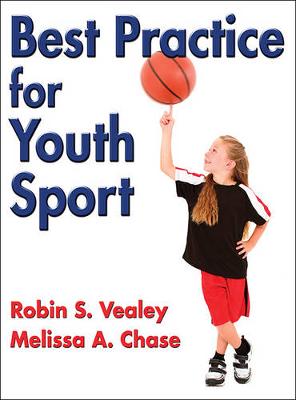
Stock image for illustration purposes only - book cover, edition or condition may vary.
Best Practice for Youth Sport
Robin S. Vealey
€ 116.94
FREE Delivery in Ireland
Description for Best Practice for Youth Sport
Hardcover. Best Practice for Youth Sport tackles the increasing professionalization and specialization of youth sport and the changing culture of youth sport. The text explores developmentally appropriate practice and encourages athlete-centered practices that are truly beneficial for young athletes. Num Pages: 432 pages, black & white illustrations, black & white halftones. BIC Classification: WS. Category: (G) General (US: Trade). Dimension: 226 x 287 x 33. Weight in Grams: 1448.
Although the physical and psychological benefits of youth participating in sport are evident, the increasing professionalization and specialization of youth sport, primarily by coaches and parents, are changing the culture of youth sport and causing it to erode the ideal mantra: It's all about the kids. In Best Practice for Youth Sport, readers will gain an appreciation of an array of issues regarding youth sport. This research-based text is presented in a practical manner, with examples from current events that foster readers' interest and class discussion. The content is based on the principle of developmentally appropriate practice (DAP), which can be defined as engaging in decisions, behaviors, and policies that meet the physical, psychological, and social needs of children and youth based on their ages and maturational levels. This groundbreaking resource covers a breadth of topics, including bone development, burnout, gender and racial stereotypes, injuries, motor behavior, and parental pressures. Written by Robin S. Vealey and Melissa A. Chase, the 16 chapters of Best Practice for Youth Sport are divided into four parts. Part I, Youth Sport Basics, provides readers with the fundamental knowledge and background related to the history, evolution, and organization of youth sport. Part II, Maturation and Readiness for Youth Sport Participants, is the core of understanding how and why youth sport is different from adult sport. This part details why it is important to know when youth are ready to learn and compete. Part III, Intensity of Participation in Youth Sport, examines the appropriateness of physical and psychological intensity at various developmental stages and the potential ramifications of overtraining, overspecialization, overstress, and overuse. The text concludes with part IV, Social Considerations in Youth Sport, which examines how youth sport coaches and parents can help create a supportive social environment so that children can maximize the enjoyment and benefits from youth sport. In addition to 14 appendixes, activities, glossaries, study questions, and other resources that appear in Best Practice for Youth Sport, the textbook is enhanced with instructor ancillaries: a test package, image bank, and instructor guide that features a syllabus, additional study questions and learning activities, tips on teaching difficult concepts, and additional readings and resources. These specialized resources ensure that instructors will be ready for each class session with engaging materials. Best Practice for Youth Sport provides readers with knowledge of sport science concerning youth sport and engages them through the use of anecdotes, activities, case studies, and practical strategies. Armed with the knowledge from this text, students, coaches, parents, administrators, and others will be able to become active agents of social change in structuring and enhancing youth sport programs to meet the unique developmental needs of children, making the programs athlete centered rather than adult centered so that they truly are all about the kids.
Product Details
Publisher
Human Kinetics
Format
Hardback
Publication date
2016
Condition
New
Number of Pages
432
Place of Publication
Champaign, IL, United States
ISBN
9780736066969
SKU
V9780736066969
Shipping Time
Usually ships in 7 to 11 working days
Ref
99-1
About Robin S. Vealey
Robin S. Vealey, PhD, is a professor in the department of kinesiology and health at Miami University in Ohio, where she has worked for more than 30 years. She has dedicated nearly her entire adult life to youth sports, whether as a coach, administrator, educator, researcher, or consultant. She is internationally known for her research on the psychological aspects of youth sport and coaching effectiveness. Vealey, who has authored three books, has won several professional awards throughout her academic career, including being named a fellow by the Association for Applied Sport Psychology (AASP) and the National Academy of Kinesiology. She previously was president of AASP, is a certified consultant in sport psychology as recognized by AASP, and is on the U.S. Olympic Committee Sport Psychology Registry. In addition to serving on numerous journal editorial review boards, Vealey is a past editor of The Sport Psychologist. In 2011, Vealey was named to the Marshall University Athletic Hall of Fame after a stellar playing career in women's basketball. Vealey went on to serve as a collegiate volleyball and women's basketball coach and an athletics administrator. She currently enjoys playing golf and continues to remain active in various sports as a sport psychology consultant for youth athletes and teams. Melissa A. Chase, PhD, is a professor in the department of kinesiology and health at Miami University in Ohio, where she has worked for two decades. She specializes in research about coaching efficacy and self-efficacy in children interested in increasing motivation and effectiveness, and she has presented her research across the United States and internationally. She was named a fellow by the Association for Applied Sport Psychology (AASP) and SHAPE America and is a certified consultant in sport psychology as recognized by AASP. Chase was the founding editor of the Journal of Sport Psychology in Action, which is an official AASP publication. Before becoming a professor, Chase gained experience as a physical education teacher at both the elementary and secondary school levels while coaching various levels of basketball, cross country, track and field, and volleyball for several years. She enjoys running and watching her teenage children participate in youth sports.
Reviews for Best Practice for Youth Sport
